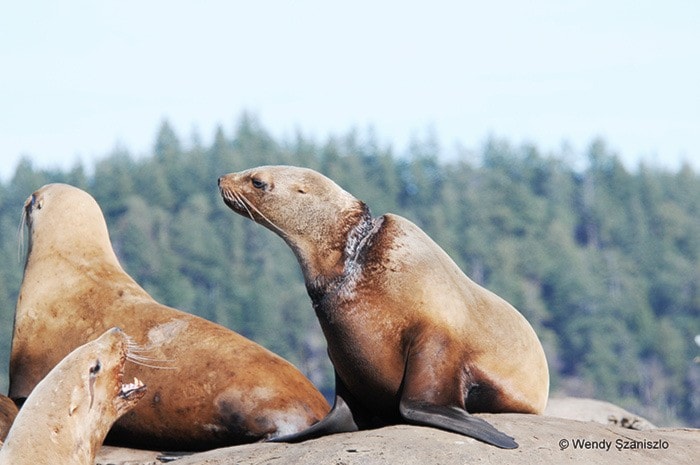Sea lions are in danger of something as simple as a plastic packing band that can be found wrapped around boxes or even a stack of newspapers.
Marine mammal ecologist and research associate at the Vancouver Aquarium Wendy Szaniszlo was in Prince Rupert on Feb. 17 to meet with approximately 40 marine professionals about what to do if an individual finds a dead, injured or entangled marine mammal off the North Coast. In the evening, she spoke to the public at the Northwest Community College about the B.C. disentanglement project.
Szaniszlo’s focus has been on entanglement since 2005 when she got involved with doing surveys off the coast and noticed scores of barking sea lions with fishing gear or marine debris wrapped tightly around their neck.
During her research, she filtered through more than 4,500 photos between 2005 and 2012 and observed 620 entanglements in the Pacific Rim Coast National Park alone. Her best guess, she said at the information session on Wednesday evening, was that there were 345 different entangled animals in those photos.
“There are likely hundreds of sea lions who become entangled in debris in B.C. at any one time,” Szaniszlo said.
In 2013, Szaniszlo began the sea lion disentanglement project. She goes out with a team of four to six people from the Vancouver Aquarium, including a veterinarian. They charter a specific vessel with a driver who is known for reading animal behaviour for $245 an hour. The Department of Fisheries and Oceans also joins them with one or two vessels with two to four staff aboard. It is no small mission.
The secret to much of their success is due to Dr. Martin Haulena, a veterinarian from the Vancouver Aquarium, who developed a drug that anaesthetizes an entangled seal without rendering the animal completely unconscious so that it can still bob and breathe if it goes into the water.
There have been nine rescue trips to date, with 11 successfully disentangled sea lions and six that have been re-sighted and seem to be doing well, said Szaniszlo. The rescue team tags the animals after to keep a watch out for them afterwards.
The crew make trips out to where there have been sightings of several entangled sea lions in a haulout, or colony.
The veterinarian darts the animal with the tranquilizer, waits 12 minutes for the drug to take effect, and approaches to disentangle. The veterinarian then injects an antibiotic and applies a topical antibiotic to the injured animal. The sea lion is tagged and given a reversal drug that wakes them up slowly.
Sometimes the crew can’t get the entangled sea lion on the shore so they have to sandwich the animal between two boats to administer the drug and remove the ligature.
Based on Szaniszlo’s research 38 per cent of entanglements are from plastic packing bands, the same found around stacks of newspapers or bait boxes. Terry St. Pierre, distribution manager at the Northern View, makes sure to cut them before throwing them out but not everyone is as cautious.
“An ounce of prevention could go a long way,” said Caitlin Birdsall, the Vancouver Aquarium coordinator for the North Coast initiative who organizes the North Coast Marine Speaker Series.
The rubber bands from crab traps are also an issue as well as fishing lures that get caught in the animal’s mouth and if ingested can cause severe damage.
For 45 per cent of entanglements Szaniszlo said the material was so tight around the sea lions’ neck it couldn’t be identified.
“This really is an issue,” she said and recommends that people can “lose the loop” by cutting it before throwing it in the trash.
People can also participate in shoreline cleanups and report any entanglement they see to Fisheries and Oceans Canada 1-800-465-4336 or the Vancouver Aquarium Marine Mammal Rescue Centre at 1-604-258-7325.
